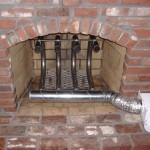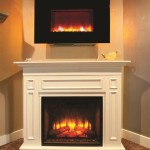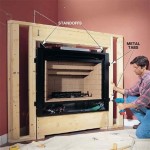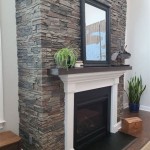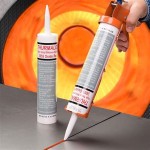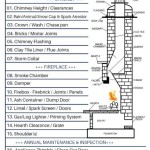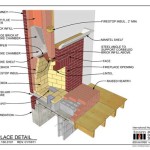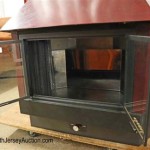Fireplace Without Surround: A Deep Dive into Minimalist Design and Practical Considerations
The traditional fireplace, often adorned with elaborate surrounds and mantels, has undergone a significant transformation in modern interior design. The fireplace without a surround, also known as a zero-clearance or frameless fireplace, presents a sleek, minimalist aesthetic that seamlessly integrates into contemporary living spaces. This design choice prioritizes the fire itself, making it the focal point of the room while minimizing visual clutter. This article delves into the various aspects of fireplaces without surrounds, exploring their design principles, installation considerations, safety requirements, and the benefits they offer to homeowners seeking a modern and uncluttered look.
A fireplace surround traditionally serves multiple purposes. It provides a decorative frame around the firebox, often incorporating a mantel for displaying ornaments and artwork. It also functions as a protective barrier, preventing heat from directly contacting adjacent walls and potentially causing damage. When a surround is removed, alternative methods are required to address these functional and aesthetic considerations. The design must carefully consider heat management, material selection, and integration with the surrounding wall or architectural elements.
The allure of a fireplace without a surround lies in its simplicity. By eliminating the ornate details of a traditional mantel and surround, the focus shifts entirely to the flames, creating a dramatic and captivating visual effect. This minimalist approach aligns with contemporary design trends that emphasize clean lines, open spaces, and the use of natural materials. The resulting effect is a sophisticated and uncluttered ambiance that enhances the overall aesthetic of the room.
Design Considerations for Fireplaces Without Surrounds
Designing a fireplace without a surround requires careful planning and attention to detail. Several key factors must be considered to ensure both functionality and aesthetic appeal. These include the type of fireplace, the surrounding wall materials, heat management strategies, and the overall integration with the room's design.
The type of fireplace significantly influences the design choices. Options include gas fireplaces, electric fireplaces, and bioethanol fireplaces. Gas fireplaces typically require venting systems and careful consideration of gas line connections. Electric fireplaces, on the other hand, offer greater flexibility in terms of placement as they only require an electrical outlet. Bioethanol fireplaces offer a ventless option, making them suitable for spaces where traditional venting is not possible. Each type of fireplace has specific installation requirements and heat output characteristics that must be factored into the design.
The selection of surrounding wall materials is crucial. Since there is no surround to protect the wall from heat, materials must be non-combustible and heat-resistant. Common choices include concrete, stone, brick, metal, and specialized fire-resistant boards. The choice of material also impacts the overall aesthetic. Concrete and stone offer a modern, industrial look, while brick can provide a more rustic or traditional feel. Metal panels can create a sleek and contemporary appearance.
Heat management is a critical consideration for fireplaces without surrounds. Without a traditional surround to deflect heat, the adjacent wall can become excessively hot, potentially posing a safety hazard or causing damage to the wall. Several strategies can be employed to mitigate this risk. Creating a recess for the fireplace can provide a buffer zone between the firebox and the wall. Installing heat shields or insulation behind the wall can further reduce heat transfer. Additionally, ensuring proper ventilation around the fireplace can help dissipate heat and prevent overheating.
Integrating the fireplace seamlessly into the room's design is essential for achieving a cohesive and aesthetically pleasing result. The fireplace should complement the existing architectural elements and furniture. Consider the scale of the fireplace in relation to the room's size. A large fireplace can overwhelm a small room, while a small fireplace may be dwarfed in a large space. Pay attention to the proportions and lines of the fireplace, ensuring they align with the overall design aesthetic. The color and texture of the surrounding wall materials should also harmonize with the room's color palette and materials.
Installation and Safety Requirements
Installing a fireplace without a surround requires adherence to strict safety standards and building codes. Proper installation is crucial to prevent fire hazards, carbon monoxide poisoning, and other potential dangers. It is highly recommended to hire a qualified and licensed professional to install the fireplace, ensuring that all safety requirements are met.
Before installation, it is essential to obtain any necessary permits from the local building authorities. Building codes vary depending on location, but they typically address issues such as ventilation, gas line connections, electrical wiring, and clearance requirements. Failure to comply with building codes can result in fines, delays, and potentially unsafe conditions.
Proper venting is critical for gas fireplaces. The venting system must be installed according to the manufacturer's specifications and in compliance with local building codes. Incorrectly installed venting can lead to carbon monoxide leaks, which are extremely dangerous. Regular inspection and maintenance of the venting system are also necessary to ensure its continued safety and efficiency.
Electrical wiring for electric fireplaces must be performed by a qualified electrician. The wiring must be properly grounded and protected to prevent electrical hazards. Ensure that the electrical circuit is adequate to handle the fireplace's power requirements. Overloading a circuit can lead to overheating and potentially cause a fire.
Clearance requirements specify the minimum distance that combustible materials must be kept away from the fireplace. These requirements are typically outlined in the manufacturer's instructions and in local building codes. Failure to maintain adequate clearance can result in overheating and potentially cause a fire. Pay close attention to the clearance requirements for the sides, top, and front of the fireplace.
Regular maintenance is essential for all types of fireplaces. Gas fireplaces should be inspected annually by a qualified technician to ensure that all components are functioning properly. Electric fireplaces should be cleaned regularly to remove dust and debris. Bioethanol fireplaces should be cleaned according to the manufacturer's instructions. Regular maintenance can help prevent problems and ensure the continued safe and efficient operation of the fireplace.
Benefits of Fireplaces Without Surrounds
Fireplaces without surrounds offer several compelling benefits, making them an attractive option for homeowners seeking a modern and minimalist aesthetic. These benefits include enhanced visual appeal, increased design flexibility, ease of maintenance, and potential space savings.
The primary benefit of a fireplace without a surround is its enhanced visual appeal. By eliminating the traditional mantel and surround, the focus shifts entirely to the flames, creating a dramatic and captivating focal point. The minimalist design complements modern interior design trends that emphasize clean lines, open spaces, and uncluttered environments. The resulting effect is a sophisticated and elegant ambiance that enhances the overall aesthetic of the room.
Fireplaces without surrounds offer increased design flexibility. They can be integrated seamlessly into a variety of architectural styles, from modern and contemporary to minimalist and industrial. The absence of a traditional surround allows for greater freedom in choosing materials and finishes for the surrounding wall. This flexibility enables homeowners to create a truly custom look that reflects their personal style and preferences.
Maintaining a fireplace without a surround is generally easier than maintaining a traditional fireplace with a surround. There are fewer nooks and crannies to clean, and the absence of a mantel eliminates the need to dust and polish decorative items. The smooth, clean lines of the design make it easy to wipe down the surrounding wall and keep the fireplace looking its best.
In some cases, a fireplace without a surround can save space compared to a traditional fireplace with a bulky mantel and surround. This is particularly beneficial in smaller rooms where space is at a premium. By eliminating the unnecessary bulk, the fireplace can be integrated more seamlessly into the room, maximizing the available space and creating a more open and airy feel.
The perceived value of a home can be influenced by the presence of a modern fireplace without a surround. Potential buyers often appreciate the clean lines and updated aesthetic, which can increase the desirability and market value of the property. A well-designed and properly installed fireplace without a surround can be a significant selling point, particularly in markets where contemporary design is highly valued.

A Modern Minimalist Fireplace Surround Contributes To The Quiet Serenity Of This Living Room

Example Of A Jetmaster Open Fire With No Surround This One Is The Extra 700 Fireplace Design
.jpg?strip=all)
How To Build Diy Movable Electric Fireplace Wall

12 Trendy Ideas Of A Fireplace Without Mantle For Minimalist Look La Urbana

The 12 Simplest Plaster Fireplace Surround Ideas To Ease Your Eyes

Pin By Michele Webber On New House Fireplace Wood Burning Stoves Living Room Stylish Home

How To Update The Look Of Your Fireplace

Vanbrugh Fireplace Including Hearth Haddonstone

The 12 Simplest Plaster Fireplace Surround Ideas To Ease Your Eyes

Verona Cast Stone Fireplace Surround Oregon Castings And Design

